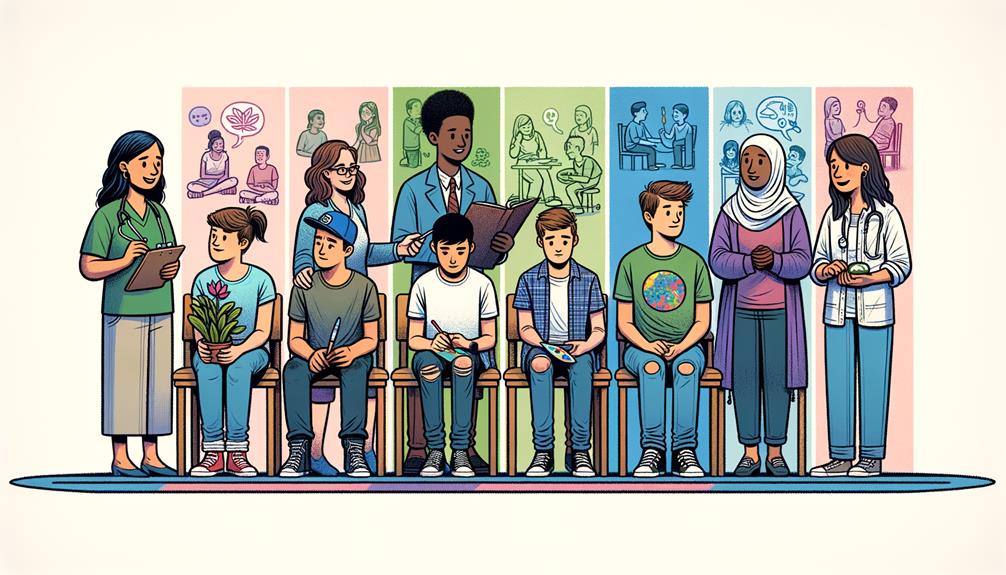So, you've stumbled upon a step-by-step guide that claims to help adolescents overcome prescription drug abuse. Sounds promising, doesn't it?
Well, hold on tight because this guide is about to take you on a journey that will unveil the scope of prescription drug abuse, equip you with the skills to identify the signs and symptoms, and provide you with the necessary tools to seek professional help for those in need.
But that's not all; you'll also learn how to implement behavioral therapies and create a supportive environment for adolescents in recovery.
Ready to dive into the depths of this critical topic? Let's begin.
Understanding the Scope of Prescription Drug Abuse

To truly address the issue of prescription drug abuse in adolescents, it's crucial to understand the extensive scope of this problem. Prescription drug abuse among teens is a growing concern, with studies showing that it's on the rise. As a parent, guardian, or concerned individual, it's vital to be informed about prevention strategies and the consequences of prescription drug abuse.
Prevention strategies play a crucial role in combatting prescription drug abuse in adolescents. Educating teens about the dangers of misusing prescription medications is essential. Encouraging open and honest communication with your teen is also important, as it fosters trust and provides an opportunity for dialogue about the risks associated with prescription drugs. Additionally, safely storing and disposing of prescription medications can help prevent access and misuse.
Understanding the consequences of prescription drug abuse is equally important. Misusing prescription drugs can lead to serious health problems, including addiction, overdose, and even death. It can also negatively impact academic performance, relationships, and overall well-being. By recognizing the potential consequences, you can empower yourself to take action and prevent prescription drug abuse in the lives of the adolescents around you.
Identifying Signs and Symptoms of Prescription Drug Abuse
How can you recognize if an adolescent is abusing prescription drugs? Early intervention is crucial in addressing prescription drug abuse among adolescents. By being aware of the signs and symptoms, you can take the necessary steps to help them. Effective communication plays a vital role in this process. It's important to create a safe and non-judgmental environment where they feel comfortable sharing their struggles with you.
Look out for behavioral changes such as sudden mood swings, increased secrecy, or a decline in academic performance. Physical signs may include changes in appetite, sleep patterns, or weight, as well as bloodshot eyes or dilated pupils. Keep an eye out for missing pills or empty prescription bottles, and notice if they're visiting multiple doctors to obtain more medication.
Listen carefully to their words and observe their actions. Are they constantly talking about prescription drugs or exhibiting defensive behavior when questioned about their use? Are they neglecting their responsibilities or engaging in risky behaviors?
If you suspect prescription drug abuse, it's important to address the issue promptly. Approach the conversation with empathy and support, expressing your concern for their well-being. Encourage them to seek professional help and offer to accompany them to appointments.
Seeking Professional Help for Adolescents With Prescription Drug Abuse

If you believe that your adolescent may be struggling with prescription drug abuse, it's essential to seek professional help as soon as possible. Remember, you aren't alone in this journey. Seeking professional intervention is a crucial step towards helping your child overcome their addiction and regain control of their life. Here are some important reasons why professional help is necessary:
- Expertise: Professionals have the knowledge and experience to address prescription drug abuse effectively. They can provide accurate diagnoses, develop personalized treatment plans, and guide your adolescent towards recovery.
- Therapy: Professional intervention involves various therapeutic approaches, such as cognitive-behavioral therapy (CBT) or motivational interviewing. These therapies help your adolescent understand the root causes of their addiction, develop coping mechanisms, and make positive behavioral changes.
Family involvement is also a key aspect of seeking professional help:
- Support: Professionals can guide you and your family through the challenges of prescription drug abuse. They provide a safe space to express your concerns, share experiences, and learn effective strategies to support your adolescent throughout their recovery.
- Education: Professionals offer educational resources and workshops to help families understand prescription drug abuse better. By gaining knowledge about the issue, you can actively participate in your adolescent's recovery and contribute to creating a drug-free environment at home.
Implementing Behavioral Therapies for Prescription Drug Abuse Treatment
As you continue seeking professional help for your adolescent's prescription drug abuse, it's important to explore effective methods of implementing behavioral therapies in their treatment. Behavioral therapy approaches are widely recognized as a vital component in addressing substance abuse issues among adolescents. These approaches focus on modifying behaviors, thoughts, and emotions that contribute to drug abuse, ultimately helping your child develop healthier coping mechanisms.
One of the key benefits of behavioral therapies is that they provide adolescents with the necessary tools to recognize and avoid triggers that may lead to drug abuse. Through techniques such as cognitive-behavioral therapy, your child will learn to identify negative thought patterns and develop strategies to replace them with positive and constructive thoughts. This can significantly reduce the likelihood of relapse and foster long-term recovery.
Another advantage of behavioral therapies is their ability to address underlying mental health issues that may contribute to prescription drug abuse. By incorporating counseling and psychotherapy, therapists can help your adolescent understand and manage any co-occurring conditions, such as anxiety or depression. Treating these underlying issues can enhance the effectiveness of the overall treatment plan and improve your child's overall well-being.
Creating a Supportive Environment for Adolescents in Recovery From Prescription Drug Abuse

Creating a supportive environment is crucial for adolescents in recovery from prescription drug abuse, as it can greatly contribute to their overall well-being and long-term success in maintaining sobriety. As a caregiver or loved one, you play a vital role in creating this environment.
Here are some key strategies to support your adolescent in their recovery journey:
- Supporting peers:
- Encourage your adolescent to connect with peers who are also in recovery. Peer support can provide a sense of belonging and understanding, as they share similar experiences and challenges.
- Help your adolescent find support groups or recovery communities where they can interact with peers who are on the same path. These groups can offer guidance, encouragement, and a sense of accountability.
- Building healthy routines:
- Establish a structured daily routine that includes regular mealtimes, exercise, and sufficient sleep. This can help your adolescent develop a sense of stability and purpose, reducing the likelihood of relapse.
- Encourage your adolescent to engage in activities they enjoy, such as hobbies, sports, or creative outlets. These activities can provide a healthy outlet for stress and boost their overall well-being.








